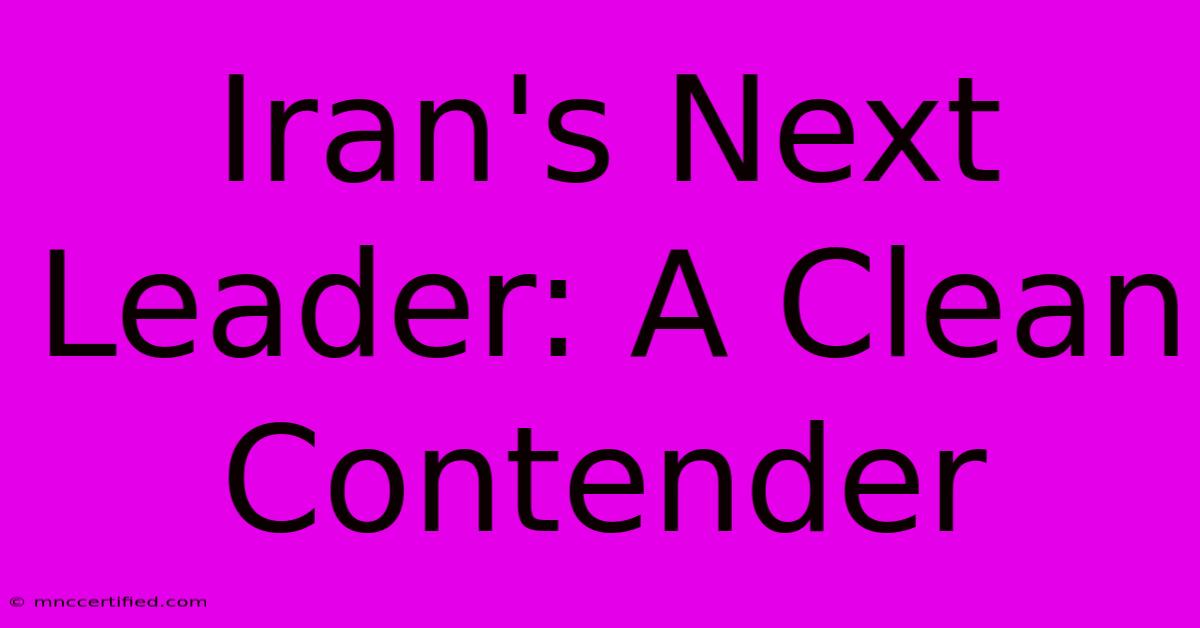Iran's Next Leader: A Clean Contender

Table of Contents
Iran's Next Leader: A Clean Contender? Navigating the Complexities of Succession
Iran's political landscape is notoriously complex, a web of interwoven religious authority, political factions, and deeply entrenched power structures. The question of who will succeed the current Supreme Leader, Ayatollah Ali Khamenei, is therefore not merely a matter of political succession; it's a pivotal moment that will shape Iran's domestic and foreign policy for decades to come. While predicting the future is inherently difficult, analyzing the potential contenders and the dynamics at play allows us to consider the possibility of a "clean" succession – one that avoids significant internal strife and maintains the existing power structure.
Understanding the Challenges of a "Clean" Succession
A "clean" succession in Iran implies a relatively smooth transition of power, minimizing internal conflict and upheaval. This is a challenging prospect given the historical context of Iranian politics and the various competing factions vying for influence. Several factors complicate this:
-
The Supreme Leader's Health: Ayatollah Khamenei's health is a primary concern. Any unexpected deterioration could trigger a scramble for power, undermining a planned transition. The lack of transparency surrounding his health only exacerbates the uncertainty.
-
Factional Divisions: Iran's political scene is fractured along various lines, including hardline versus reformist factions and different interpretations of Islamic jurisprudence. These internal divisions could easily erupt into open conflict during a succession crisis.
-
The Role of the Assembly of Experts: This body is responsible for electing the Supreme Leader. Its composition and internal dynamics will play a crucial role in shaping the outcome of the succession process. The influence of various factions within the Assembly will be a determining factor.
-
Military Influence: The Iranian Revolutionary Guard Corps (IRGC) wields significant power and influence. Its support or opposition towards a particular candidate will significantly impact the succession process.
Potential Contenders: A Landscape of Power
While pinpointing the next Supreme Leader is impossible, several prominent figures are frequently mentioned as potential candidates. Analyzing their strengths and weaknesses is crucial for understanding the possible scenarios:
-
Ebrahim Raisi: Currently the President of Iran, Raisi is a prominent hardliner with strong connections within the conservative establishment. His popularity among hardliners is a significant asset, but his hardline stance might hinder broader acceptance.
-
Mohsen Rezaei: A former commander of the IRGC, Rezaei is another influential hardliner. His military background gives him considerable leverage, but his potential candidacy could exacerbate tensions with more moderate factions.
-
Other Key Figures: Several other senior clerics and political figures are quietly positioned as potential successors. The lack of transparency surrounding their ambitions makes it difficult to assess their chances.
The Importance of a "Clean" Succession for Iran and the World
A smooth transition of power is not just a matter of internal Iranian politics. It has significant implications for regional stability and international relations. A contested succession could lead to:
-
Increased Internal Instability: Leading to potential social unrest and possibly even violent conflict.
-
Regional Tensions: A power vacuum or a contentious transition could embolden Iran's regional rivals and escalate existing conflicts.
-
Impact on the Nuclear Deal: The outcome of the succession could affect Iran's commitment to the nuclear agreement and its relationship with the international community.
Conclusion: Uncertainty and the Road Ahead
Predicting Iran's next Supreme Leader with certainty is impossible. However, understanding the complexities of the succession process, the key players, and the potential challenges is crucial. Whether Iran witnesses a "clean" succession remains to be seen. The coming years will be a critical period, shaping not only Iran's future but also the regional and global landscape. The interplay between factions, the health of the current Supreme Leader, and the decisions of the Assembly of Experts will ultimately determine the course of this pivotal moment in Iranian history. The international community will be watching closely.

Thank you for visiting our website wich cover about Iran's Next Leader: A Clean Contender. We hope the information provided has been useful to you. Feel free to contact us if you have any questions or need further assistance. See you next time and dont miss to bookmark.
Featured Posts
-
Long Term Care Insurance Louisiana
Nov 17, 2024
-
Where To Watch Clemson Vs Pitt Football Today
Nov 17, 2024
-
Husker Football First Win Update
Nov 17, 2024
-
Grim Film Paynes Death Impact
Nov 17, 2024
-
Can You Whiten Teeth With Bonding
Nov 17, 2024